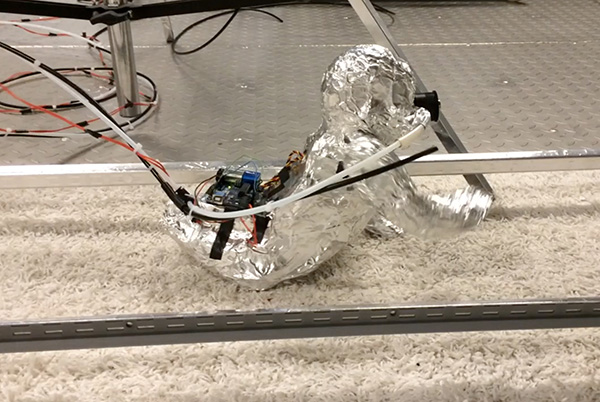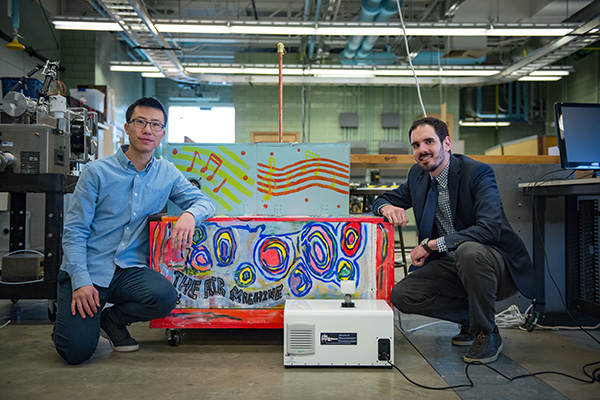Robotic baby kicks up dust — for science
When those adorable infants crawl across the carpet, they kick up a cloud of unsavory substances. Down there on their hands and knees, the babies are releasing — and inhaling — dirt, skin cells, bacteria, pollen and fungal spores.
But just how much unpleasant stuff is released into the air? And how much does the baby breathe in? Brandon Boor, Assistant Professor of Civil Engineering, decided to find out. Boor and his research team built a robotic baby that both kicks up particles and monitors how much it inhales.
"We used state-of-the-art aerosol instrumentation to track the biological particles floating in the air around the infant in real time, second by second," Boor says. "The instrument uses lasers to cause biological material to fluoresce. Most bacterial cells, fungal spores and pollen particles are fluorescent, so they can be reliably distinguished from nonbiological material in the air. We also worked with a microbiology group at Finland's National Institute for Health and Welfare, which conducted DNA-based analysis of the microbes we collected onto filters."

A robot baby was used to determine how much biological material crawling infants stir up from carpets. Researchers found that crawling children receive inhalation doses four times that of an adult walking across the same floor.
A cloud of crud
The researchers found that a concentrated cloud of resuspended particles forms and that the concentrations around the baby can be as much as 20 times greater than the levels of material in the bulk air of the room. Moreover, infants' bodies are not good at blocking this dust storm, Boor says.
"For an adult, a significant portion of the biological particles are removed in the upper respiratory system, in the nostrils and throat," he says. "But very young children often breathe through their mouths, and a significant fraction is deposited in the lower airways — the tracheobronchial and pulmonary regions. The particles make it to the deepest regions of their lungs."
As alarming as this might all sound, Boor was quick to add that this is not necessarily a bad thing.
"Many studies have shown that inhalation exposure to microbes and allergen-carrying particles during infancy plays a significant role in both the development of, and protection from, asthma and allergic diseases," he says. "Studies have shown that being exposed to a high diversity and concentration of biological materials may reduce the prevalence of asthma and allergies later in life."
The next (baby) step
Through a new grant from the National Science Foundation, Boor will explore the factors that influence the adhesion and resuspension of biological particles in early-childhood indoor microenvironments. Boor is collaborating with the Infant Action Lab in the NYU Psychology Department to investigate how infant locomotion dynamics affect resuspension and exposure. Following this work, the team will study an active child care facility.
To do this, the researchers will use a bioaerosol sensor, a standalone device located in various rooms in a day care center. Dubbed "The Air Machine," the sensor will track the fluorescence properties of bacteria, fungi and pollen, so researchers can see how many bacteria are stirred up as a real child scoots or toddles by.
As with the previous phase, PhD student Tianren Wu, who builds the experimental devices, will dedicate much of his time to collecting data.
"This will be a fascinating part of the study — as with many other studies — because we are finally moving from a controlled setting to the real world," Wu says. "In this next phase, we will gain great insight into exactly how many particles are kicked into the air through crawling and walking."
The "live" phase of the air particle study is slated to begin in the fall of 2019.

In the next phase of testing, Assistant Professor Brandon Boor (right) and PhD student Tianren Wu will use 'The Air Machine' in a child care facility to study the amount of particles kicked up in a live, child-heavy environment.
